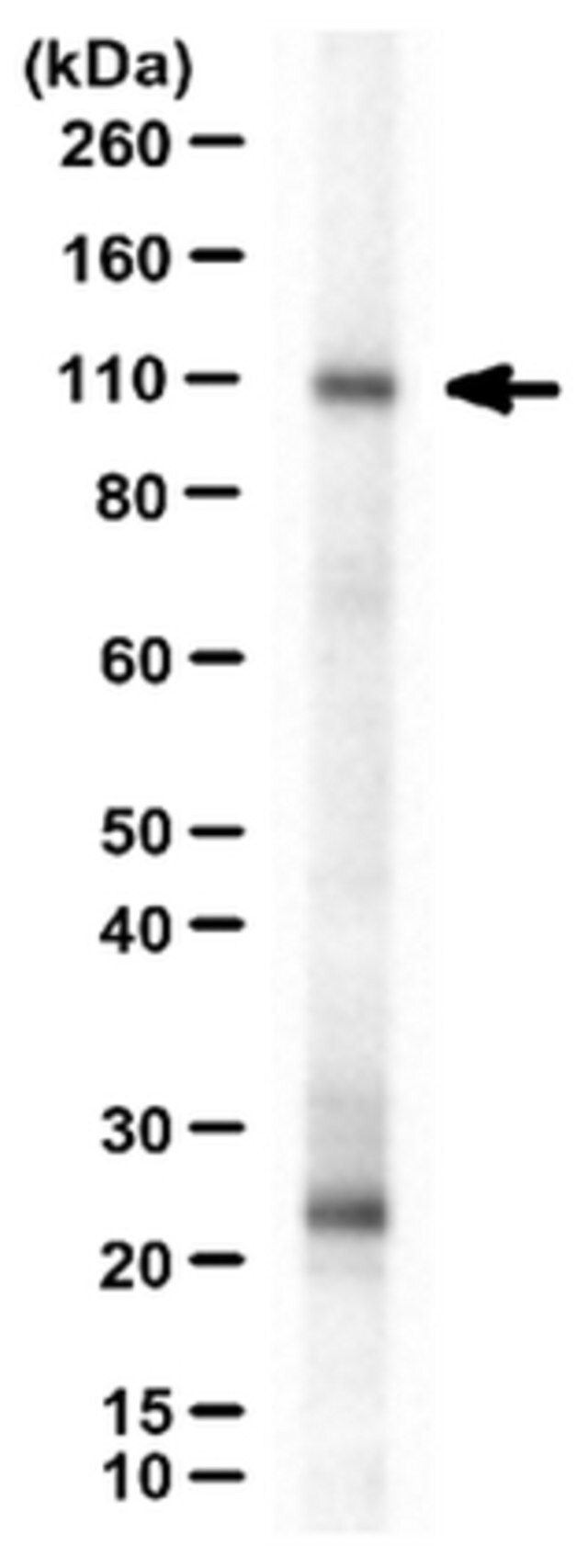您的位置:首页 > 产品中心 > Anti-Neph1 Antibody, cytoplasmic domain
Anti-Neph1 Antibody, cytoplasmic domain

| 产品编号: | 4110846 |
| 规格: | from rabbit, purified by affinity chromatography |
| 包装规格: | 100 μL |
| 产品类别: | 进口试剂 |
| 品牌: | Sigma-Aldrich |
| 优惠价: | 立即咨询 |
产品别名
Anti-Neph1 Antibody, cytoplasmic domain
Kin of IRRE-like protein 1, Kin of irregular chiasm-like protein 1, Nephrin-like protein 1, Neph1, cytoplasmic domain
基本信息
| eCl@ss | 32160702 |
| NACRES | NA.41 |
| General description【一般描述】 | Kin of IRRE-like protein 1 (UniProt Q80W68; also known as Nephrin-like protein 1, Kin of IRRE like 1, Kin of irregular chiasm-like protein 1) is encoded by the Kirrel (also known as 6720469N11Rik, Kirrel1, Neph1) gene (Gene ID 170643) in murine species. Podocytes are specialized epithelial cells that are critical components of the glomerular filtration barrier. Glomerular injury, such as that caused by renal ischemia, is often characterized by the effacement of podocytes, loss of slit diaphragms, and proteinuria. The podocyte proteins Neph1 and nephrin are critical for maintaining the structural integrity of slit diaphragm and therefore the filtration function of the glomerulus by organizing a signaling complex at the podocyte cell membrane. Cytoplasmic domain of Neph1 plays a key role in actin cytoskeleton remodeling events that are directly associated with Fyn-mediated Neph1 pTyr637/638 phosphorylation that leads to the recruitment of adapter proteins and signaling molecules, such as Grb2, Csk tyrosine kinase, and ZO-1. Phosphorylation-induced association between Neph1 and ZO-1 plays a key role in defining the tight junction formation in podocytes. |
| Specificity【特异性】 | Expected to react with murine spliced isoforms 1&2, as well as all three human spliced isoforms. |
| Immunogen【免疫原】 | Epitope: cytoplasmic domain His-tagged recombinant protein corresponding to the cytoplasmic domain of mouse Neph1. |
| Application【应用】 | Western Blotting Analysis: A representative lot detected endogenous rat glomeruli Neph1 and exogenously expressed mouse Neph1 in COS-7 cells (Barletta, G.M., et al. (2003). J Biol Chem. 278(21):19266-19271). Western Blotting Analysis: A representative lot detected ischemia-induced Neph1 membrane-to-cytosol translocation in human podocytes (Wagner, M.C., et al. (2008). J Biol Chem. 283(51):35579-35589). Western Blotting Analysis: A representative lot detected Neph1 in mouse glomeruli & cultured human podocytes (Arif, E., et al. (2011). Mol Cell Biol. 31(10):2134-2150). Immunoprecipitation Analysis: A representative lot immunoprecipitated Neph1 from rat glomerular and human podocyte cell lysates (Arif, E., et al. (2011). Mol Cell Biol. 31(10):2134-2150). Immunofluorescence Analysis: A representative lot detected Neph1 using both paraffin-embedded and frozen rat kidney sections (Arif, E., et al. (2011). Mol Cell Biol. 31(10):2134-2150; Barletta, G.M., et al. (2003). J Biol Chem. 278(21):19266-19271). Electron Microscopy Analysis: A representative lot detected Neph1 in frozen rat kidney sections (Barletta, G.M., et al. (2003). J Biol Chem. 278(21):19266-19271). Immunocytochemistry Analysis: A representative lot detected Neph1 in cultured human podocytes (Arif, E., et al. (2014). J Biol Chem. 289(14):9502-9518; Arif, E., et al. (2011). Mol Cell Biol. 31(10):2134-2150; Wagner, M.C., et al. (2008). J Biol Chem. 283(51):35579-35589). Research Category Signaling Research Sub Category Signaling Neuroscience Detect Neph1 using this rabbit Polyclonal Anti-Neph1 Antibody, cytoplasmic domain, Cat. No. ABS1511, validated for use in Western Blotting, Immunoprecipitation, Immunofluorescence, Electron Microscopy and Immunocytochemistry. |
| Quality【质量】 | Evaluated by Western Blotting in rat kidney tissue lysate. Western Blotting Analysis: A 1:1,000 dilution of this antibody detected Neph1 in rat kidney tissue lysate. |
| Physical form【外形】 | Purified rabbit polyclonal antibody in buffer containing PBS/glycine/5% BSA, .02% Sodium Azide and 30% glycerol. Affinity purified |
| Other Notes【其他说明】 | Concentration: Please refer to lot specific datasheet. |
产品性质
| biological source【生物来源】 | rabbit |
| Quality Level【质量水平】 | 100 |
| antibody form【抗体形式】 | affinity isolated antibody |
| antibody product type | primary antibodies |
| clone【克隆】 | polyclonal |
| purified by【纯化方式】 | affinity chromatography |
| species reactivity | rat, human, mouse |
| technique(s) | electron microscopy: suitable immunocytochemistry: suitable immunofluorescence: suitable immunoprecipitation (IP): suitable western blot: suitable |
| NCBI accession no.【NCBI登记号】 | NP_001164456 |
| UniProt accession no.【UniProt登记号】 | Q80W68 |
| shipped in【运输】 | wet ice |
产品说明
| Target description【目标描述】 | ~110 kDa observed. Target band size appears larger than the calculated molecular weight (87.2 kDa/murine isoform 1, 70.0 kDa/murine isoform 2, 72.4-85.0 kDa/human isoform 1-3) due to posttranslational modifications (glycosylation & phosphorylation). An uncharacterized band ~25 kDa can also be seen in some samples. |
| Storage and Stability【储存及稳定性】 | Stable for 1 year at -20°C from date of receipt. Handling Recommendations: Upon receipt and prior to removing the cap, centrifuge the vial and gently mix the solution. Aliquot into microcentrifuge tubes and store at -20°C. Avoid repeated freeze/thaw cycles, which may damage IgG and affect product performance. Note: Variability in freezer temperatures below -20°C may cause glycerol containing solutions to become frozen during storage. |
| Disclaimer【免责声明】 | Unless otherwise stated in our catalog or other company documentation accompanying the product(s), our products are intended for research use only and are not to be used for any other purpose, which includes but is not limited to, unauthorized commercial uses, in vitro diagnostic uses, ex vivo or in vivo therapeutic uses or any type of consumption or application to humans or animals. |
安全信息
| Storage Class Code【储存分类代码】 | 10 - Combustible liquids |
| WGK | WGK 3 |




